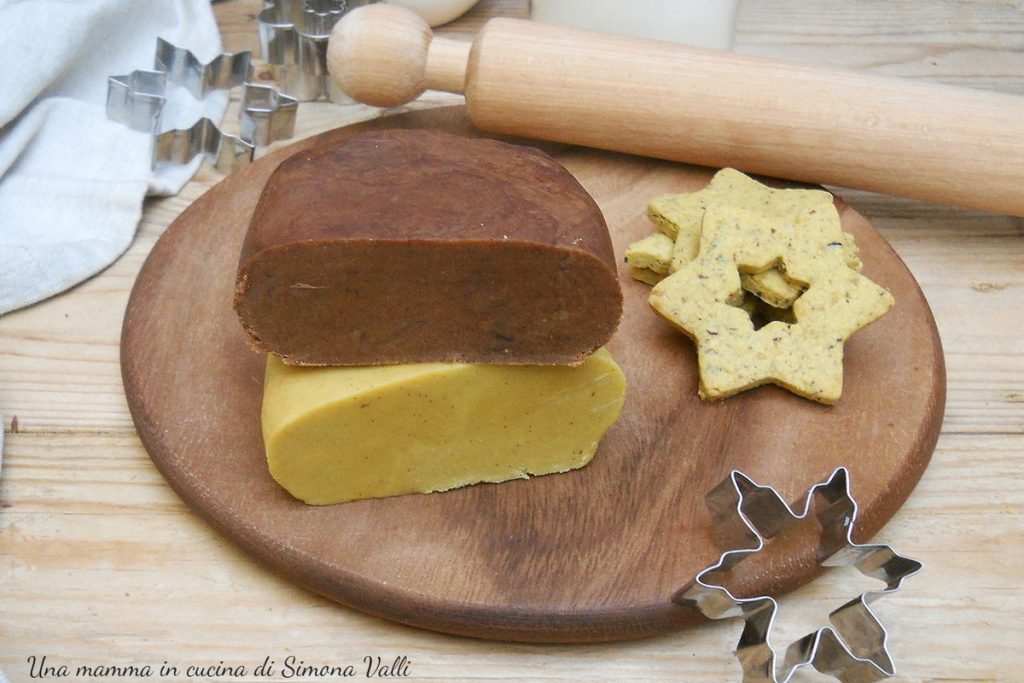The pistachio shortcrust pastry is an enriched version of the basic shortcrust pastry; adding pistachio flour, pistachio paste, and optionally some chopped pistachios, you get a delicious dough ideal for cookies, tarts, and tartlets. For a perfect shortcrust, it is necessary to balance all the ingredients every time and work them with the correct procedure.
You can mix it in a stand mixer or with electric beaters, but it’s important to work it quickly to avoid the formation of gluten that would prevent your cookies from becoming crumbly, which is why a weak flour, about 150/180W is used.
When the shortcrust is ready, it should stabilize in the fridge for a few hours, then worked quickly to make it plastic, and it’s ready for use.
In the last two years, I’ve attended many courses with Luca Montersino, my absolute favorites are the basic pastry courses, which are definitely the most complex but also the most rewarding. Thanks to the shortcrust pastry course I am now able to create all the variants I desire. Making a shortcrust seems very simple but to prepare an enriched dough that is workable, doesn’t crumble, rolls out without breaking, and gives a perfect result in baking, the correct technique is needed.
Today I leave you MY PISTACHIO SHORTCRUST PASTRY RECIPE with which you can have fun making filled tarts, cookies, mini tarts, and tartlets,
Here are some variants of shortcrust pastry available on my blog:

- Difficulty: Easy
- Cost: Medium
- Rest time: 2 Minutes
- Preparation time: 10 Minutes
- Portions: 640 g of pistachio shortcrust
- Cooking methods: Electric oven
- Cuisine: Italian
- Seasonality: All seasons
- Energy 471.69 (Kcal)
- Carbohydrates 48.30 (g) of which sugars 18.26 (g)
- Proteins 9.18 (g)
- Fat 27.86 (g) of which saturated 11.89 (g)of which unsaturated 7.37 (g)
- Fibers 3.12 (g)
- Sodium 7.65 (mg)
Indicative values for a portion of 100 g processed in an automated way starting from the nutritional information available on the CREA* and FoodData Central** databases. It is not food and / or nutritional advice.
* CREATES Food and Nutrition Research Center: https://www.crea.gov.it/alimenti-e-nutrizione https://www.alimentinutrizione.it ** U.S. Department of Agriculture, Agricultural Research Service. FoodData Central, 2019. https://fdc.nal.usda.gov
Ingredients
- 2 cups all-purpose flour (150-180 W)
- 1/2 cup butter
- 3/4 cup pistachio flour
- 2 tbsp pistachio paste (pure with 100% pistachios)
- 1 cup powdered sugar
- 4 large egg yolks
- 1/3 pod vanilla (the inner pulp)
- 2 tbsp unsweetened cocoa powder (to replace the same amount of flour)
Tools
- 1 Stand mixer
- 1 Pastry board
- 1 Rolling pin
- 1 Scale
Method
The method I chose for making my pistachio shortcrust pastry is the traditional method. The fats (at a temperature of about 57°F) are whipped with the sugar in a stand mixer, the liquids are added, and finally the flours.
The butter for preparing this type of shortcrust should not be too cold, the optimal temperature is around 57°F. It may seem trivial, but the butter temperature is fundamental for achieving a perfect shortcrust. If you use cold butter from the fridge, at about 39°F, it won’t be workable and won’t allow the flour to be impermeable, compromising your cookies’ success.
The pistachio flour plays a very important role, always use top-quality raw materials.
Before proceeding with the preparation of the shortcrust, leave the butter at room temperature for 10 minutes; the correct temperature is around 57°F.
Split the vanilla pod and extract the pulp.
In a stand mixer fitted with a K-beater or flat beater, add the butter cut into cubes, pistachio paste, powdered sugar, vanilla seeds, and blend the mixture until well combined. Add the yolks, one at a time, and let them incorporate.
If you don’t have a stand mixer, mix the shortcrust in a bowl using an electric whisk.
At this point, add the flours to the stand mixer and incorporate quickly.
Form a dough, wrap it in cling film, and place it in the fridge to stabilize for 2 hours.
After resting in the fridge, you need to make the shortcrust plastic. It’s a simple and quick operation but necessary to have a homogeneous dough that doesn’t break and rolls out perfectly.
Take the dough from the fridge, cut it into pieces, and knead it quickly by hand or in the stand mixer (with the hook) to make it workable. 30/40 seconds are enough, just the time needed for it to recombine without heating up.
The pistachio shortcrust pastry is ready for your recipes.
To obtain the cocoa version, make exactly the same recipe, replacing 10 g of flour with 10 g of cocoa.
Every oven bakes differently, the cooking times I leave you are those of my oven, and the times vary depending on the recipe you want to make.
If you want to prepare cookies, roll out the shortcrust pastry to a thickness of 5 mm and bake them in a preheated static oven at 340°F for 10/12 minutes.
If you want to prepare a tart, roll out the shortcrust pastry to a thickness of 3 mm, line the buttered mold, and fill it as desired; the cooking time varies depending on the filling:
for a jam tart, 30 minutes at 340°F are sufficient
for a ricotta-filled tart, the times extend by at least 10 minutes.
Mini tarts bake in about 20 minutes while tartlets bake in 12/13 minutes.
Tips
For recipe-making tips, contact me on FACEBOOK and if you like, follow me on INSTAGRAM
Send me your photos, I will happily publish them on my social media

